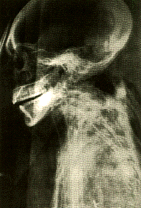SACRED
NOISE & PROFANATION invites the viewer to experience an unusual
space and modify the nature of the surrounding soundscape by its sole
movement. It is an exploration of different interaction modes without
using conventional visual interfaces (i.e. screen-based interfaces).
Two different types of sensors are used. Hanging from the ceiling, infrared
sensors detect the presence (or absence) of viewers in a narrow vertical
field located just beneath. These sensors transmit a binary value to
the computer. Halfway between ground and ceiling are disposed 8 telemetric
ultrasound sensors. These sensors detect the relative position of the
viewers in a narrow horizontal field and send continuous values (in
a 128-step range) to the processing unit. To each sensing device is
associated a distinct sound source which is modified in real time by
the surrounding activity.
Following certain rules and conditions, information is managed by the
control software (Max) and allows interaction between the system and
the viewers on specific limited but well-defined parameters; events
triggering, sound samples selection, dynamic intensity, pitch change,
rythm variation.
Eight "pieces" of about 3 minutes each propose an exploration
of different interaction through various soundscapes. The complete cycle
is then approximatively 25 minutes long, but each cycle is different
from the others as the viewers movement is never the same and always
changing.
The soundtrack is composed of simple structures of loops and repetitive
patterns in order to make the viewer's action on the system much more
understandable. These soundbites are generated in real time by the computer
thru sixteen speakers distributed all over the space. The lighting system
allows the viewer to "visualize" the sensing fields as well
as contributing to the overall ambiance.
SACRED NOISE: "Any prodigious sound or noise which is exempt from
social proscription. Originally, such natural phenomena as thunder,
volcanic eruptions, storms, and so on, were regarded as sacred noise,
as they were believed to represent divine combats or divine displeasure
with man. By analogy, the expression may be extended to social noises
which, during certain periods of history, have escaped the attention
of noise abatement legislators, e.g. church bells, industrial noise,
moozak, amplified pop music, etc."
Truax, B., Murray Schafer, R.,
Handbook for Acoustic Ecology no. 5 (p. 108)

